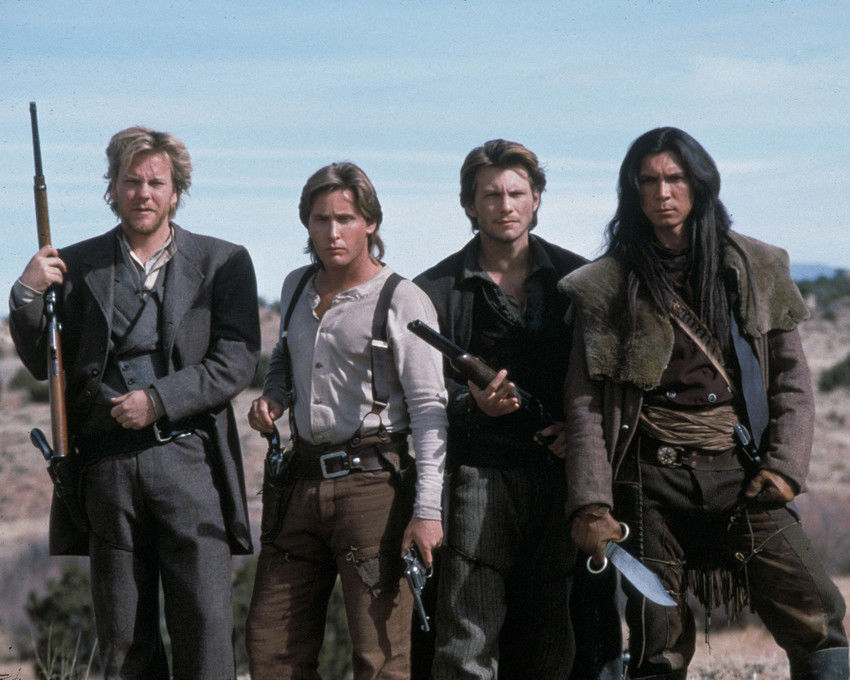Behind the Scenes: Young Guns (1988)
The cast of Young Guns didn’t just play a band of outlaws—they actually became one. Emilio Estevez, Kiefer Sutherland, Charlie Sheen, Lou Diamond Phillips, and Dermot Mulroney spent weeks bonding in the high desert of New Mexico. Off camera, they rode horses, learned to shoot, drank whiskey by campfires, and got into a few too many late-night scuffles. That real-life camaraderie bled into every frame of the film, giving their brotherhood an edge of authenticity that’s hard to fake.
Those gunfights on screen? Not just Hollywood sleight of hand. Many of the cast members had never even handled firearms before filming began. They were trained by professional wranglers, but even with expert guidance, things didn’t always go smoothly. Dermot Mulroney had a close call when a blank misfired too close to his ear, causing temporary hearing loss. After that, the safety protocols got a serious upgrade.
Emilio Estevez took his role as Billy the Kid personally. He buried himself in dusty biographies and folklore, trying to find the man beneath the legend. He practiced Billy’s smirk, his cocky walk, and even did a lot of his own stunt work—like when Billy escapes from jail in that legendary shootout.
One of the coolest things? A real descendant of Brushy Bill Roberts—the man who claimed to be Billy the Kid—visited the set and shared stories passed down through generations. It added a layer of myth that made the cast lean even further into the idea that maybe Billy didn’t die that night in Fort Sumner.
Charlie Sheen’s early death in the movie took a lot of fans by surprise, especially since he was one of the biggest stars in the cast. But it was no mistake—Charlie had scheduling conflicts with other films, and his role was always meant to be a short, powerful jolt of realism. His death set the stakes: nobody was safe in the Lincoln County War.
Behind the Scenes: Young Guns II (1990)
By the time Young Guns II rolled around, the vibe had shifted. The first film had become a cult hit, and now the sequel had to ride that momentum. But instead of playing it safe, they went bolder—with bigger shootouts, deeper emotions, and an unforgettable soundtrack.
Jon Bon Jovi was only supposed to contribute one song to the film, but after reading the script, he was so inspired he wrote an entire album. “Blaze of Glory” became an anthem—not just for the movie, but for the idea of riding out your days with defiance and style. And yes, that was Jon making a cameo as a doomed prisoner in the opening scene. If you blink, you might miss it.
Christian Slater joined the cast as Arkansas Dave Rudabaugh and quickly shook things up. He improvised lines, challenged Billy’s authority on-screen, and brought a chaotic energy that was exactly what the film needed. The tension between Billy and Rudabaugh wasn’t just acting—it was real competition between two young actors trying to own every scene.
Kiefer Sutherland had a rough ride—literally. He’d injured himself in a horse accident just before filming, but toughed it out and kept riding, often in pain. You can see it in his posture during certain scenes, especially wide shots. It added a ruggedness to Doc that you can’t fake.
Lou Diamond Phillips had to refresh all the riding and gun skills he hadn’t used since the first film. But more importantly, he dove deeper into Chavez y Chavez’s indigenous heritage this time, determined to give the character a more grounded, respectful portrayal. His quiet, stoic energy balances out Billy’s wild side.
Many of the scenes were shot out of order to capture the right light and mood in New Mexico’s unpredictable desert. Some days, the actors would film their death scenes in the morning, then a flashback to a lighter moment in the afternoon. It created a strange, emotional roller coaster that weirdly helped the cast tap into the bittersweet mood of the story.
Filming took place in real historical locations—Fort Sumner, White Oaks, Lincoln County—where Billy the Kid had actually walked, fought, and maybe died. That energy soaked into the performances. It wasn’t just a movie anymore—it felt like a chance to rewrite a piece of legend.
And maybe the wildest secret of all? Young Guns II was always meant to set up a third film. Emilio Estevez had pages of ideas for what would happen next: an aging Billy, alive and in hiding, being tracked by a new threat. But the studio never followed through—until recently, when whispers of Young Guns 3 started to ride again.





No comments:
Post a Comment